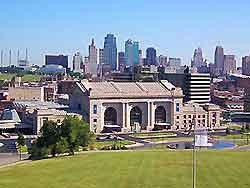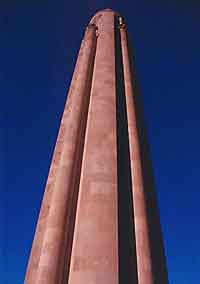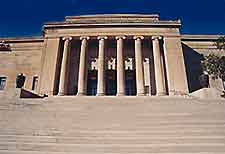Kansas City History Facts and Timeline
(Kansas City, Missouri - MO, USA)

World-famous for its contribution to blues and jazz styles, Kansas City lies in Missouri State, on the Kansas and Missouri rivers.
Kansas City's impressive history includes changes of ownership between the British, the French and the Spanish, before it was signed over to the newly formed United States in 1803.
Early Days
In the early to mid-18th century, the lands surrounding the present city were occupied by Native American tribes and a few French-Canadian fur trappers. In the late 1700s, the first survey of these lands, largely undisturbed by developments, was undertaken. Guillaume Delisle, the cartographer who carried out the survey, was aided by descriptions of the area written earlier by a deserter of the French forces at Fort Detroit.
By 1763, the Spanish Empire was in control of the area through the Treaty of Paris, although the French fur traders and trappers went about their business mostly undisturbed after they were granted licenses to continue. Some 60 years later, a successful fur trading dynasty, the Chouteaus, arrived in the Kansas City area and established a settlement.

Early 19th Century
Various attempts to enlarge the settlement early on in the history of Kansas City met with little success, including the arrival from
New York of a large group of Mormon pioneers who, after establishing schools and dwellings in the town in 1833, were forced to leave following violent protests at their way of life. Finally, in 1833 and 1834, two more settlements were begun by Baptist missionary John Calvin McCoy, close to and on the river. By 1850, the landing on the river was incorporated as Kansas City, with McCoy celebrated thereafter as the city's founder.
Set at the heart of three westward pioneer routes - the Santa Fe, the Oregon and the California trails, the town developed quickly, with approximately 2,500 residents registered by 1853. However, passions ran high on the subject of slavery in the region, with the pre-Civil War years seeing a series of violent confrontations, known as Bleeding Kansas, between anti- and pro-slavery elements.
Civil War
Kansas City was heavily involved in the American Civil War (1861 to 1865), with intense military activity mostly taking place outside the city limits. The state itself was divided between those in favor of slavery and those bitterly opposed to it, with the first major conflict in 1862 ending in favor of the Confederate Army, although the fortified city was in Union hands and impossible to overcome.
The second battle in this period of Kansas City history also favored the Confederates, but was again a hollow triumph, as the crucial Battle of Westport that followed saw the Confederate Army smashed.
Post-war Reconstruction
After the Civil War, Kansas City history saw the city surge in growth, with the construction of a new rail bridge over the Missouri River causing a population explosion, along with the western and eastern extension of the borders of the city. By 1900, the city was home to over 163,000 people and was a shining light of the 'City Beautiful' movement for its parks, green spaces, attractive boulevards and fine architecture.

20th Century to the Present Day
Construction was the byword during Kansas City's early 20th-century history, although a tax evasion scandal orchestrated by a popular politician was discovered in 1939, just as WWII broke out. The post-WWII suburban development continued apace, with wealthy residents moving from the city center to the newly fashionable suburbs.
The city center slums that formed would become breeding grounds for the Kansas City Riots, which broke out in 1968, in response to Martin Luther King's assassination. City center regeneration took place during the latter half of the century and, by 2012, the population numbered more than half a million.
 World-famous for its contribution to blues and jazz styles, Kansas City lies in Missouri State, on the Kansas and Missouri rivers.
World-famous for its contribution to blues and jazz styles, Kansas City lies in Missouri State, on the Kansas and Missouri rivers.
